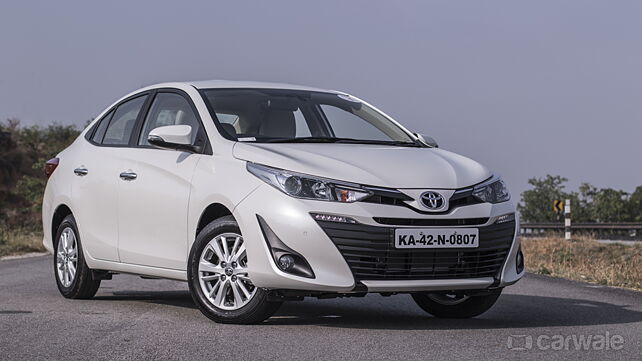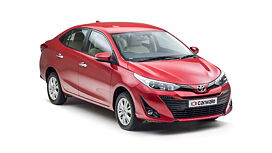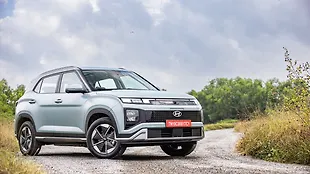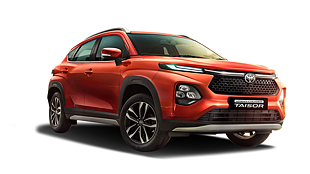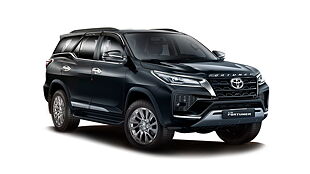What is it?

Why would I buy it?
Great all-rounder, loaded with features
Why would I avoid it?
Lacks emotional appeal, interior fit and finish could have been better
After the disappointment that was the Etios, Toyota is back with a brand-new sedan and this time around, they aren’t leaving any stones unturned. Armed with plenty of equipment and a torquey petrol engine, the brand-new Yaris will go up against the ever popular Honda City, the value for money Ciaz and the well-received new Hyundai Verna. So has Toyota cracked the sedan nut the second time around? We went to Bengaluru to find answers.

The Yaris, at first glance, comes across as a safe approach from Toyota designers. Upfront it looks striking thanks to the aggressive slim headlamps, a sharp two-tone bumper and the sporty nose element with the Toyota logo proudly sitting on it. Apart from the front-end, the Yaris looks balanced but that is nothing to get excited about. The profile is plain and even the crease that runs across the doors is a bit flat and uninspiring. The alloy wheels too are generic and the modest 15-inch rim size makes the Yaris look undertyred. The boot section is more appealing thanks to the well detailed wrap around tail lamps and the bulging rear bumper.
Based on the Toyota’s B platform which also underpins the Yaris hatch in developing markets, the Yaris sedan shares its wheelbase of 2550mm, not only with the hatchback but also with the ageing Etios which suggests that the carmaker is using it as the basis to keep costs down. The Yaris weighs in between 1090-1135kg across variants and transmissions, which makes it 28kg heavier than the Honda City and more than 100kg on the weightier side than the Maruti Ciaz.
How is it on the inside?

The exterior character of the Yaris is carried over on the inside too. There is nothing to get excited about with the dash design, as all the shapes and curves are as conventional as they come. All the same, the waterfall design of the centre console looks nice and the fact that they have placed the screen high up on the dash makes it easy to use on the move. Ergonomics are good too with logical placement of important controls and things like the air-con buttons are placed relatively high and have chunky buttons which is again well thought, as you don’t have to search for them. In the CVT VX variant the Pioneer touchscreen system is sensitive and the processing speed is good too. But there was screen quality is ordinary and the graphics didn't look modern too. You also get a DVD player in this system but the opening and closing mechanism is flawed as to load a DVD the screen flips open but to close it there is no physical button and you have to search for the closing command on the tilted screen to shut it. In comparison the Panasonic unit on the lower V variant had a better screen and graphics. But it doesnt come with navigation and it isn't as intuitive as the Pioneer unit.
As far as quality goes, it is decent but not great and bits like the rear armrest cup holders and some of the dash plastics isn’t of the highest quality. Even the faux stitching on the dash top panels look fake and won't be to everyone's tastes. In terms of comfort the Yaris hits the sweet spot. The seats are well contoured, the cushioning is soft but not overtly so and underthigh support in both rows is ample too.

Although there is enough space at the back for adults, it isn't nearly as roomy as its direct rivals. On our measuring tape, the Yaris was short by a massive 3cm as compared to the City and 7cm to the Ciaz in terms of kneeroom. For people looking at the the Yaris as a five-seater, they will be disappointed by the narrow cabin. Here too it falls short of the City by 2cm and the Ciaz by 7cm.

As far as practicality goes the Yaris fares really well with a lot of cup holders, big door pockets and a deep cooled glovebox too. The boot at 476 litres might sound small, but it is deep, well shaped and the loading lip is nice and low. You also get 60:40 split folding rear seats which is a segment first and adds to its practical nature.

As mentioned earlier, the Yaris really excels when it comes to standard features. In the base J variant you get features like keyless entry, projector headlamps, driver seat height adjust, music system, 60:40 split folding rear seat and projector headlamps. The higher G variant adds keyless go, auto climate control, roof mounted air vents, rear parking sensors and touchscreen infotainment system among others. The higher V variant comes with additional features like alloy wheels, auto headlamps, LED tail lamps, cruise control, rain sensing wipers, rear disc brakes and front parking sensors. The top VX variant is packed with even more unique features. This includes leather seat upholstery, daytime running lights, rear sun blind, powered drivers seat, a higher grade touch screen with gesture control and navigation, ESP and hill start assist. The biggest highlight, however, is Toyota offering seven airbags, ABS and ISOfix seats as standard accross the range. So it doesn't matter which Yaris variant you buy, it will come loaded with features. We did find some obvious features missing though. Things like one touch lane change indicator, telescopic steering adjust and auto dimming rear view mirror are surprisingly omitted.

How does it drive?

Initially the Yaris will just come with a petrol engine option while transmission options are that of a 6-speed manual and 7-step CVT automatic gearbox. This naturally aspirated motor is based on the engine found in the Etios. Displacing 1496cc it even shares its bore and stroke with the older engine, but now it gets variable valve timing that help it produce better output. As a result it makes 105bhp of power (17bhp more than in the Etios) and the torque figure has gone up too. Like in the older engine, max torque of 140Nm is delivered at a low 4200rpm which should aid drivability.

Start this motor and it settles into a quiet and vibe free idle. As soon as you start moving you will really appreciate the low-end torque this engine delivers as the Yaris pulls off the line in a strong yet linear manner. Driving this CVT transmission shod car in traffic is very easy and it doesn't have a pronounced lag (typical of a CVT gearbox). But depressing the accelerator above half brings about a drastic rise in engine revs rise without equivalent momentum gain. On the plus side the transmission does feel better calibrated than the one on the Honda City which fares far worse. Out on the highway, the Yaris automatic does do a respectable job and cruises at three digit speeds with ease. Like with most CVT gearboxes it also coasts off-throttle in pursuit of saving fuel. On the downside there is no engine braking whatsoever and you have to shift to manual mode especially descending down a ghat section. Overall CVT transmission works brilliantly in the city and quite well on the highway too.
Moving on to the manual version, it gets six cogs and the gearshifts on this gearbox are extremely positive and the short throws make it a joy to use. This gearbox also lets the engine’s torquey character come to the fore and be it in gear at any rpm, this 1.5 litre motor pulls cleanly and strongly. Its driveability is good enough that you can easily pull in from as low as 50kmph in sixth! This also means gearshifts are kept to a minimum thus reducing fatigue. But this engine gets quite noisy past 4000rpm and its best to shift early and use this motors immense torque.

The stress free nature of the engine is complemented by its absorbent ride. In the beginning, the Yaris comes across as stiff at low speeds but then it surprises you with solid composure and good suspension travel even over worst of potholes. Except for really sharp edged ruts, the suspension works silently too. Even at high speeds the Yaris stays level over rippled, undulating or broken tarmac which makes it a great long distance companion.
On the drive we didn't encounter any ghat section but at high speeds through sweeping bends, the Yaris felt rock solid and body roll was well contained too. The steering felt direct and well weighted at high speeds but a tad too heavy while ambling along in the city. We had the top variant on test with all round disc setup. The initial bite was sharp and the pedal felt progressive enough to give the Yaris good stopping power.
Should I buy one?

Like most Toyota's, the Yaris comes across as capable, practical, reliable, well equipped, but lacks a bit of jazz which can be very important in this segment. Be it on the outside or the inside, it lacks the flair that the likes of the Hyundai Verna and the Honda City offer or even the space of the Ciaz or the City. But as an overall product you can't really go wrong with the Yaris. What it lacks in quality and emotional appeal it tries to make up with a strong petrol engine, a good automatic option. The seats are comfortable, it is very well equipped and the ride quality is absorbent too. Will the Yaris fare better than the Etios? Absolutely yes. Will it trouble the likes of the City, Verna and the Ciaz? Well it depends a lot on the pricing which we will come to know in a few weeks time.
Where does it fit in?

The Yaris will go up against very stiff competition. It will rival the Honda City, Maruti Ciaz, the Hyundai Verna, the Skoda Rapid and the Volkswagen Vento. If Toyota manages to undercut the Honda City and price it at par with the Verna and the Ciaz then we think it stands a very good chance of doing well.
Pictures by: Kapil Angane

